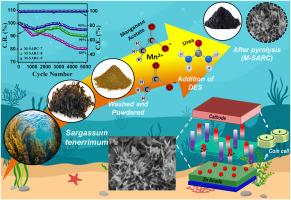以DES为绿色溶剂制备棕海藻源高性能电极,作为锌离子电池的有效阴极
IF 5.8
2区 生物学
Q1 AGRICULTURAL ENGINEERING
引用次数: 0
摘要
在这项研究中,我们提出了一种可持续和经济的方法,直接从褐藻马尾藻(Sargassum tenerrimum, SAR)和绿色溶剂共晶混合物中合成复合材料。这一创新工艺产生了β-MnO2,与来自SAR的碳相结合,标志着其首次应用。通过在不同温度范围(700°C - 900°C)的惰性大气条件下进行的直接热解技术,将海藻有效地转化为介孔β-MnO2@SARC。最初,海藻颗粒被用作主要原料,而由尿素和醋酸锰形成的共晶混合物被用作前驱体和催化剂,用于大规模和直接制造β-MnO2@SARC (M-SARC)复合材料。这些复合材料的温度分别为M-SARC@900°C、M-SARC@ 800°C和M-SARC@700°C,是专门为锰基阴极设计的,针对水性锌离子电池(azib)进行了优化。在硬币电池配置中,使用M-SARC @ 900°C构建的AZIB显示出令人印象深刻的159 mAh/g (0.1 a /g)的比容量,显示出卓越的电荷存储效率。与M-SARC@800°C和M-SARC@700°C相比,它还表现出了出色的长期稳定性,在1 A/g的条件下,在5000次充放电循环后保持了95%的容量。此外,通过动力学研究对M-SARC@900°C复合材料中锌的储存机理进行了全面的考察和分析。这项研究最终为开发价格合理且高性能的水基ZIBs阴极材料奠定了基础。本文章由计算机程序翻译,如有差异,请以英文原文为准。

Brown seaweed-derived high-performance electrode prepared using DES as green solvent to serve as effective cathode in aqueous Zn-ion battery
In this study, we present a sustainable and cost-effective method for synthesizing a composite directly from brown seaweed Sargassum tenerrimum (SAR) along with a green solvent eutectic mixture. This innovative process resulted in the creation of β-MnO2 integrated with carbon sourced from SAR, marking its inaugural application. The efficient conversion of seaweed into mesoporous β-MnO2@SARC was accomplished through a direct pyrolysis technique performed under inert atmospheric conditions at various temperature ranges (700 °C–900 °C). Initially, granules of seaweed were utilized as the primary raw material, while a eutectic mixture formed from urea and manganese acetate was used as both the precursor and catalyst for the large-scale and straightforward fabrication of β-MnO2@SARC (M-SARC) composites. These composites, designated as M-SARC@900 °C, M-SARC@ 800 °C, and M-SARC@700 °C, were specifically designed as manganese-based cathodes, optimized for use in aqueous Zinc ion batteries (AZIBs). In a coin cell configuration, the AZIB constructed with M-SARC @ 900 °C demonstrated an impressive specific capacity of 159 mAh/g (at 0.1 A/g), showcasing remarkable charge-storage efficiency. It also exhibited exceptional long-term stability, retaining 95 % of its capacity after 5000 charge-discharge cycles at 1 A/g, in contrast to M-SARC@800 °C and M-SARC@700 °C. Furthermore, the zinc-storage mechanism in the M-SARC@900 °C composite was comprehensively examined and analyzed through kinetic studies. This research ultimately lays the groundwork for the advancement of affordable and high-performance cathode materials for aqueous ZIBs.
求助全文
通过发布文献求助,成功后即可免费获取论文全文。
去求助
来源期刊

Biomass & Bioenergy
工程技术-能源与燃料
CiteScore
11.50
自引率
3.30%
发文量
258
审稿时长
60 days
期刊介绍:
Biomass & Bioenergy is an international journal publishing original research papers and short communications, review articles and case studies on biological resources, chemical and biological processes, and biomass products for new renewable sources of energy and materials.
The scope of the journal extends to the environmental, management and economic aspects of biomass and bioenergy.
Key areas covered by the journal:
• Biomass: sources, energy crop production processes, genetic improvements, composition. Please note that research on these biomass subjects must be linked directly to bioenergy generation.
• Biological Residues: residues/rests from agricultural production, forestry and plantations (palm, sugar etc), processing industries, and municipal sources (MSW). Papers on the use of biomass residues through innovative processes/technological novelty and/or consideration of feedstock/system sustainability (or unsustainability) are welcomed. However waste treatment processes and pollution control or mitigation which are only tangentially related to bioenergy are not in the scope of the journal, as they are more suited to publications in the environmental arena. Papers that describe conventional waste streams (ie well described in existing literature) that do not empirically address ''new'' added value from the process are not suitable for submission to the journal.
• Bioenergy Processes: fermentations, thermochemical conversions, liquid and gaseous fuels, and petrochemical substitutes
• Bioenergy Utilization: direct combustion, gasification, electricity production, chemical processes, and by-product remediation
• Biomass and the Environment: carbon cycle, the net energy efficiency of bioenergy systems, assessment of sustainability, and biodiversity issues.
 求助内容:
求助内容: 应助结果提醒方式:
应助结果提醒方式:


